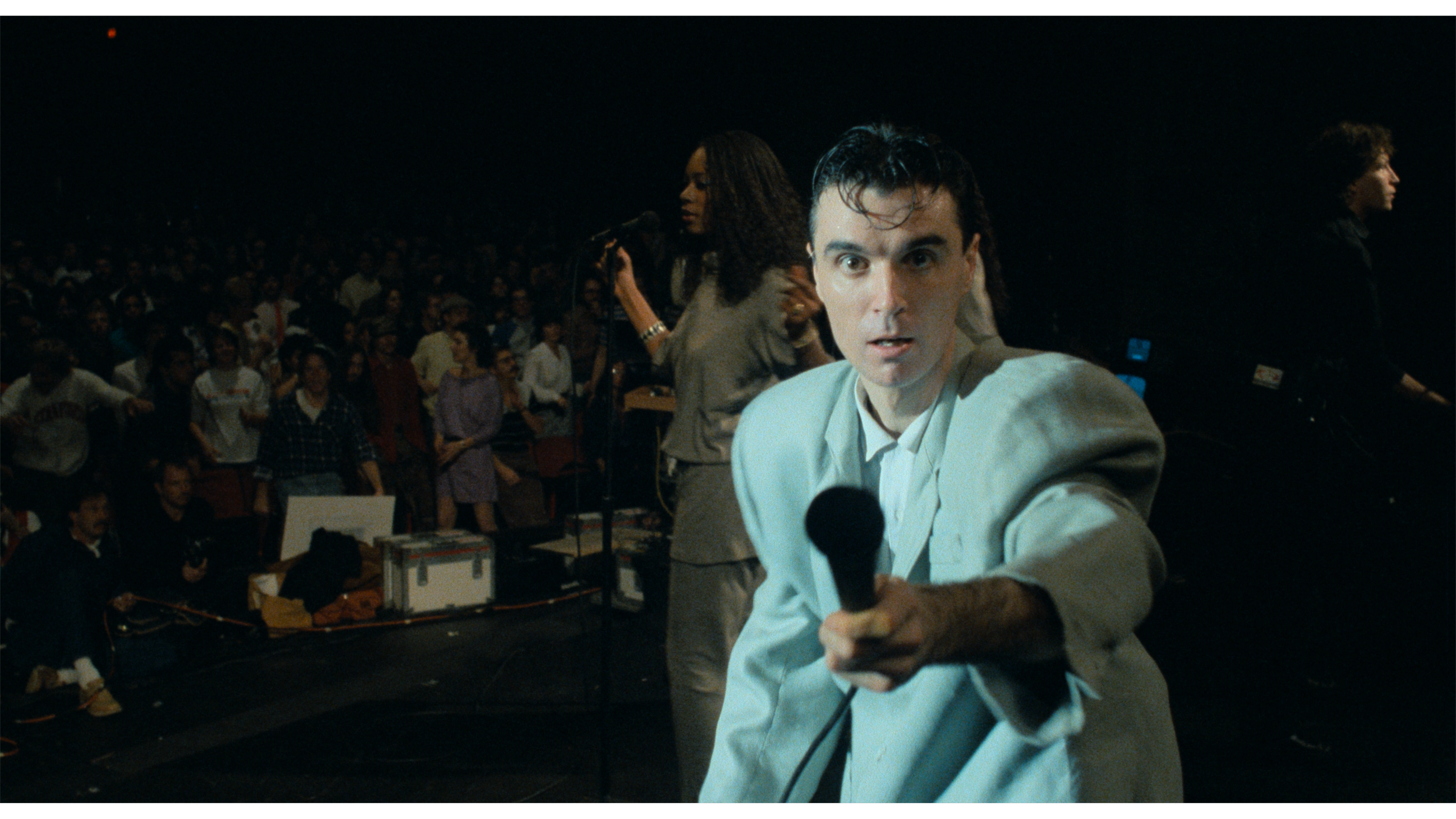“Think of when you’re at a concert,” explained Talking Heads guitarist and keyboardist Jerry Harrison as he discussed the 4K remastering of “Stop Making Sense.” “It’s always best to be in the middle as both your eyes and ears are getting a well-balanced experience, but we tried to mix music so that it would sound great wherever you were sitting.”
A24’s dynamic restoration of what is widely considered the greatest concert film of all time is far from the same as it ever was, and the theatrical experience recreates the experience of being in the audience as closely as is technologically possible without it being overpowering.
“To begin with, we bring the audience in when they reacted to the original, but we were very judicious and restrained about the amount of the audience tracks,” the musician explained. “I guess we just tried to make it feel natural.”
Filmed at the Pantages Theatre in Los Angeles over three nights in December 1983, using six cameras for each show, “Stop Making Sense” is being presented in IMAX for the first time and with a completely remastered soundtrack.
“The fact there is new technology meant we almost have a burden to adapt and bring it up to what people can hear now in theaters,” Harrison explained during a post-screening Q&A following its premiere at the Toronto International Film Festival. One of the first films to digitally record the sound, the decision made the band and director Jonathan Demme “pioneers.” Harrison added that by using digital, any copies were identical, which meant the final mixes maintained “the punch of the original recordings.”
For the latest and purest presentation of the groundbreaking project, the band and creative team wanted to recreate those original performances as accurately and realistically as possible. That involved using Dolby Atmos where available, as it could be used to envelop the theatrical audience.
“Jonathan [Demme] maintained a sense of the band being in front of the audience throughout the film until the very end where one sees them,” Harrison, who worked on the project with his longtime engineer Eric “ET” Thorngren, recalled. “We tried to make the sound conform to what you would hear at a concert. There are reflections in every room that give each one its sense of space. In general, we used the rear speakers to give the audience the feeling of being in a great-sounding concert hall.”
However, they occasionally “panned instruments around the room because it enhanced the performances,” placing Lynn Mabry’s “ethereal” backup vocals “in the ceiling and the rears to give her voice a ‘celestial’ effect.”

The remastered audio presentation utilizes 11 channels: center, left, right, side left and right, left and right rear, four ceiling speakers, and a subwoofer. However, Harrison explained, the IMAX format is “a little different” as there is no separate subwoofer, so “each speaker can play the low tones that would be assigned to the sub. We converted the 11-channel mix to fit the IMAX format.”
Whether the version one experiences is Dolby Atmos or IMAX multichannel, the audio came from the original multitrack recordings and was remixed from scratch, a process that took around a year (the visual element got underway in March 2023). The final product had to hit the September deadline for TIFF. At first, the team — which included James Mockoski, the archivist and restoration supervisor for Francis Ford Coppola’s American Zoetrope — believed the closest thing to the original negative they had was the 1999 rerelease, an interpositive version created by Demme for the film’s 15th anniversary. However, they found the original, believed lost, in the MGM vaults library in Kansas despite MGM never having anything to do with the original companies that released “Stop Making Sense.”
Once they had that, Mockoski did a 4K scan of each frame of the original 35mm print to ensure the picture had “a clarity and precision” that wouldn’t degrade or decrease with multiple screenings. He also spent six weeks cleaning the movie at his California home before sending the files to Roundabout Entertainment in Burbank to begin the HDR color correction.
That itself posed a challenge in the upscaling.
“You must be careful in the transfer not to undo the color balances and brightness that our fantastic DP, Jordan Cronenweth, created,” Harrison explained, adding, “We were fortunate to have his son as an advisor on the scan to 4K.”
So what does “Stop Making Sense” in IMAX offer audiences that previous incarnations did not?
“Since this film was never in the IMAX landscape, this afforded us the ability to offer a different presentation rather than a restoration. What you will release in home video and regular theaters is more of what we would consider the restoration and faithful to the original look and feel of the film,” Mockoski said. The conversion to IMAX also had its hurdles.
“When converting to IMAX, small problems tend to be magnified to a much larger scale, and we had to be on the lookout for problems that are only apparent on such a large screen, such as grain, dirt, and scratches. The film is presented in 1.85 in both IMAX and regular theaters. IMAX was able to blow the film up and still maintain the 1.85 aspect ratio.”
Whether audiences experience the remastered presentation of “Stop Making Sense” in one of the 200 IMAX theaters or one of the 500-plus Dolby Atmos locations, each theater will have the most optimized version of the film for that particular technical setup, offering the cleanest, clearest, best sounding, and most immersive experience possible. That’s something worth singing about.
“Stop Making Sense” will be released theatrically by A24 on September 22.



